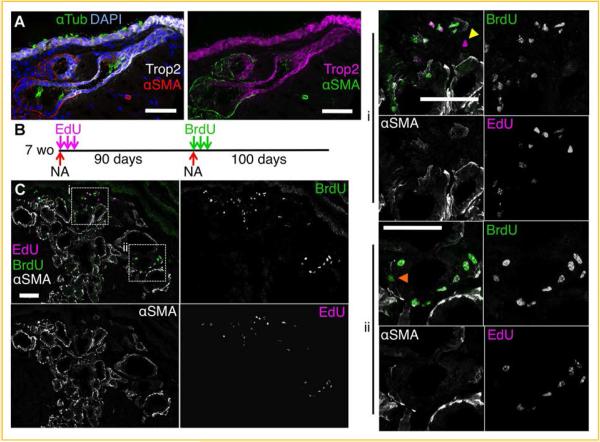Fig.3.
Slowly cycling SMG progenitor cells reside in clusters with in SMG ducts. A:αSMA is expressed in glandular serous acini and mucous tubules but is not expressed in ductal epithelia of the glands. Trop2 is expressed in the surface airway epithelium and in gland ducts, but is not expressed in serous acini or mucous tubules. B:Seven-week-old mice were injured with a single i.p. injection of naphthalene (NA) (300µg/g bodyweight) and dividing cells were labeled with three i.p. injections of EdU (25µg/g bodyweight) over 6 days. The mice were allowed to recover from this initial injury for 90 days, during which time dividing cells diluted the initial EdU label. Mice were injured again with an i.p. injection of naphthalene (300µg/g bodyweight) and dividing cells were labeled with three i.p. injections of BrdU (50µg/g bodyweight) over 6 days. Mice were allowed to recover for 100 days, during which time dividi cell diluted both nucleotide labels. C: Each of the nucleotides were then localized together with αSMA using either antibody staining (for BrdU) or with a chemical ion (for EdU). Label-retaining cells (LRCs) are cells that replicated and incorporated labeling nucleotide analogues from the pulses after injury, but subsequently remained relatively quiescent. Cells that continued to divide diluted the nucleotide analogue(s) beyond a detectable level. Nucleotide double-positive LRCs are progenitors that re-entered the cell cycle during the second regeneration phase and re-established a quiescent phenotype. A representative photomicrograph shows LRCs and recycling LRCs localized in clusters within glandular ducts that are αSMA-negative. Arrowheads mark single EdU-positive LRCs (yellow) or BrdU-positive LRCs (orange). The majority of LRCs are unmarked and double positive for EdU and BrdU. All scale bars= 50µm, and all single channel panels are the same scale as their respective merged panels.

